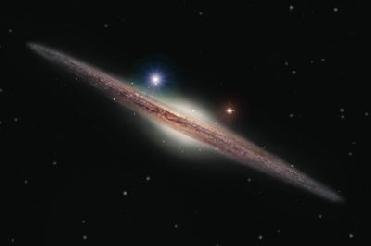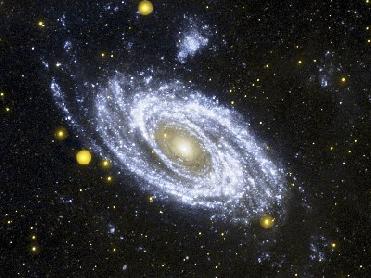
Artist's impression of the new source HLX-1 in the periphery of the edge-on spiral galaxy ESO 243-49. Photo credit: Heidi Sagerud
NEW DELHI (BNS): A new class of black hole, more than 500 times the mass of the Sun, has been discovered by an international team of astronomers.
The new discovery in a distant galaxy approximately 290 million light years from Earth is the first solid evidence of a new class of medium-sized black holes, Science Daily reported Thursday.
The new black hole was detected by a team led by astrophysicists at the Centre d'Etude Spatiale des Rayonnements in France with the European Space Agency's XMM-Newton X-ray space telescope.
Dr Sean Farrell of the Department of Physics and Astronomy, University of Leicester said, "This is the best detection to date of such long sought after intermediate mass black holes. Such detection is essential. While it is already known that stellar mass black holes are the remnants of massive stars, the formation mechanisms of supermassive black holes are still unknown."
"The identification of HLX-1 is therefore an important step towards a better understanding of the formation of the super-massive black holes that exist at the centre of the Milky Way and other galaxies,” he added.
Astrophysicists had for a long time believed that there might be a third, intermediate class of black holes, with masses between a hundred and several hundred thousand times that of the Sun. However, such black holes had not been reliably detected until now.
This new source, dubbed HLX-1 (Hyper-Luminous X-ray source 1), lies towards the edge of the galaxy ESO 243-49. It is ultra-luminous in X-rays, with a maximum X-ray brightness of approximately 260 million times that of the Sun, it said.
The X-ray signature of HLX-1 and the lack of a counterpart in optical images confirm that it is neither a foreground star nor a background galaxy, and its position indicates that it is not the central engine of the host galaxy.
Using XMM-Newton observations carried out on the 23rd November 2004 and the 28th November 2008, the team showed that HLX-1 displayed a variation in its X-ray signature. This indicated that it must be a single object and not a group of many fainter sources. The huge radiance observed can only be explained if HLX-1 contains a black hole more than 500 times the mass of the Sun. No other physical explanation can account for the data, it added.
A black hole is a remnant of a collapsed star with such a powerful gravitational field that it absorbs all the light that passes near it and reflects nothing.
 Previous Article
Previous Article Next Article
Next Article











The Indian Air Force, in its flight trials evaluation report submitted before the Defence Ministry l..
view articleAn insight into the Medium Multi-Role Combat Aircraft competition...
view articleSky enthusiasts can now spot the International Space Station (ISS) commanded by Indian-American astr..
view article